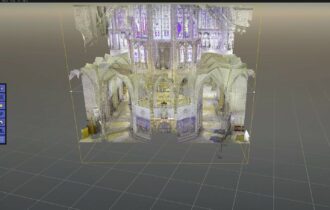
3D Viewer to Measure the Visual Impact of Offshore Wind Farms
The ecological and political situation we find ourselves in is accelerating the search for new energy sources to curb climate change.
The current energy sector, dominated by fossil fuels, is responsible for 73% of man-made greenhouse gas emissions. At this point, we are at a time when these emissions must be halved by 2030 to avoid more severe extreme and dangerous weather events such as heat waves, floods, and devastating droughts.
We know the energy sector will only achieve the much sought-after zero emissions if a significant global push accelerates innovation. But we are starting from a point where there is a massive disconnect between the climate targets, governments, and businesses. The key lies in the efforts to develop more advanced and cheaper technologies that will achieve these targets attainable for all.
Offshore wind energy market
The International Energy Agency (IEA) estimates that offshore wind will account for approximately half of Europe’s wind power generation by 2040. Looking further into the future, the European Commission forecasts that offshore wind will grow from 12 GW today to more than 60 GW in 8 years.
Furthermore, a plan has been put forward to double the installed offshore wind power capacity, a challenge that will be met with an investment of over 30 billion euros. In fact, the war in Ukraine has accelerated the process of reducing dependence on fossil fuels, and many countries are already investing heavily to make this energy transition as soon as possible.
Newly built offshore wind has become cheaper than fossil energy in just six years. And as more farms are installed, costs are falling. As a result, the cost of electricity production through wind power is expected to fall by 23-30% by 2030 and 35-41% by 2050.
Offshore wind energy potential
Offshore wind energy allows countries to take full advantage of this wind resource while revitalizing coastal communities and unlocking the full potential of energy resources by allowing access to deepwater sites that were previously inaccessible.
This is why many energy planners have chosen offshore wind as their energy plan for the future. These floating wind farms use cutting-edge energy to generate renewable, clean, carbon-free power, making them a significant game-changer in the global energy transition.
They produce affordable and reliable energy, revitalizing coastal communities and creating jobs for the future. In addition, they offer large-scale decarbonization solutions, turbines can be located at greater distances, streamline operation and maintenance (reducing costs), have higher production, and, most importantly, are a renewable, unlimited, and clean energy source.
On the other hand, the current areas of development and potential for offshore wind energy development are significant and continue to expand.
Visual Impact Analysis
The technologies currently in use are helping significantly to reduce emissions, but we need to go a step further to ensure net zero and the security of energy systems. Innovation is the key to promoting new technologies and advancing existing ones to reach all sectors.
When installing offshore wind farms, their impact on the ecosystem they are to be built must be considered. Mainly, it is necessary to consider their visual impact on a natural environment, which can be decisive when giving the green light or canceling a project. It is here where external interests or misinformation can arise that could jeopardize the future of this type of park. Technology, as on so many occasions, has become the best ally to verify the viability of such projects.
We assume that there are many problems that energy companies have to deal with to carry out this type of project: early response from the authorities to obtain consent, optimizing the design, delays in authorizations, possible resistance from public opinion, the need to provide a detailed environmental impact report, etc.
Visual Impact Analysis (VIA) aims to integrate consideration of visual impacts into orderly, safe, and environmentally responsible renewable energy development activities. As such, VIA has become a crucial part of offshore wind energy development to assess the visual effects of a proposed project and comply with local legislation. In addition, visual simulations have proven to be the most significant component of the VIA analysis.
Viawind
This is where Viawind comes in, our 3D tool that shows the most reliable, realistic, and scientifically rigorous view of what the project will look like and how it will fit into the environment.
It is a 3D simulation that analyzes this visual impact through a visual representation with eight navigable key observation points and is based on Evergine. In addition, it simulates day and night effects; simulates luminosity according to time; presents the real rotation of the wind turbines according to their location; gives key information and statistics on images, turbines, and perceived dimensions; is valid for any type of fixed and floating foundations, etc.
Some of the advantages include:
- Eliminates inaccuracies and approximations.
- Accurately informs the public and stakeholders about potential visual impacts.
- Reduces the time needed to inform stakeholders and find common ground.
- Quickly detects potential impacts, easily applying corrective measures to re-run the simulation.
- Ensures compliance with local legislation.
- Improves project approval rate and permitting times.
How do we do it?
We use a panoramic photograph, select two representative points of each location and define the horizon line as a reference to place the turbines. Then, we calculate the turbine’s size to obtain the image’s size and pixels, which allows us to understand the predominant orientation of the blades.
All done with mathematical calculations, it gives us an ultra-realistic simulation of the wind turbines, where we can see them in motion and with an accurate angle concerning the coastline. This and the integration with the photographs we get using Evergine to process and render the 3D CAD models achieve the results you can see in the video below.
In addition to the viewer, the tool includes other functionalities such as a Home with all the project information, a general map with access to each observation point, a cursor through the panoramic view to see an authentic representation of the project, a drop-down menu to move through the different points, night simulation, information and statistics on the most important data and a live demo. We put at your disposal a powerful and unique tool in the market.
We put at your disposal a powerful tool unique in the market. If you want to know more, do not hesitate to contact us!


